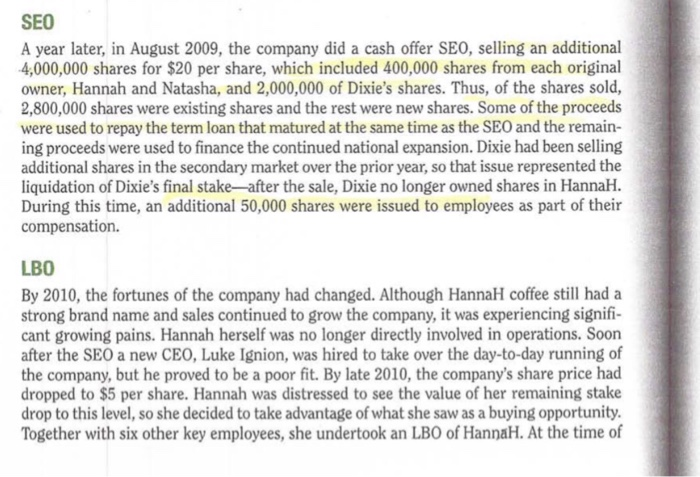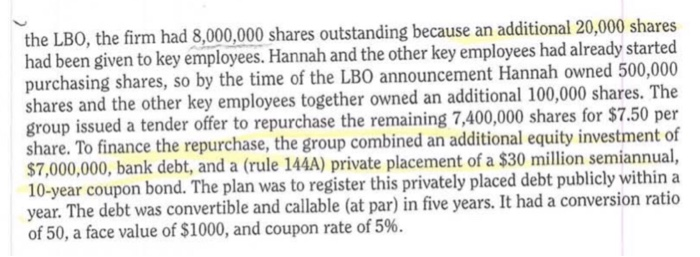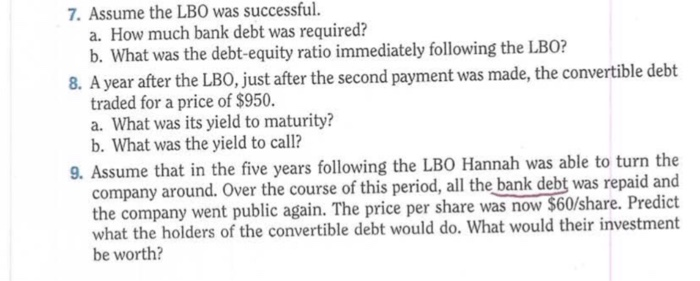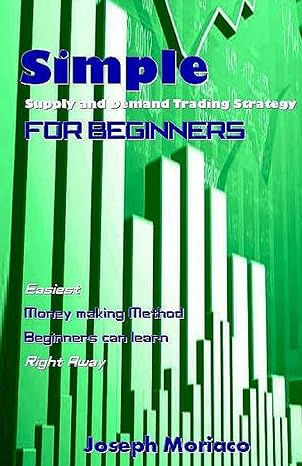SEO A year later, in August 2009, the company did a cash offer SEO, selling an additional 4,000,000 shares for $20 per share, which included 400,000 shares from each original owner, Hannah and Natasha, and 2,000,000 of Dixie's shares. Thus, of the shares sold, 2,800,000 shares were existing shares and the rest were new shares. Some of the proceeds were used to repay the term loan that matured at the same time as the SEO and the remain- ing proceeds were used to finance the continued national expansion. Dixie had been selling additional shares in the secondary market over the prior year, so that issue represented the liquidation of Dixie's final stake-after the sale, Dixie no longer owned shares in HannaH. During this time, an additional 50,000 shares were issued to employees as part of their compensation. 0 0 LBO By 2010, the fortunes of the company had changed. Although HannaH coffee still had a strong brand name and sales continued to grow the company, it was experiencing signifi- cant growing pains. Hannah herself was no longer directly involved in operations. Soon after the SEO a new CEO, Luke Ignion, was hired to take over the day-to-day running of the company, but he proved to be a poor fit. By late 2010, the company's share price had dropped to $5 per share. Hannah was distressed to see the value of her remaining stake drop to this level, so she decided to take advantage of what she saw as a buying opportunity. Together with six other key employees, she undertook an LBO of HannaH. At the time of 0 the LBO, the firm had 8,000,000 shares outstanding because an additional 20,000 shares had been given to key employees. Hannah and the other key employees had already started purchasing shares, so by the time of the LBO announcement Hannah owned 500,000 shares and the other key employees together owned an additional 100,000 shares. The group issued a tender offer to repurchase the remaining 7,400,000 shares for $7.50 per share. To finance the repurchase, the group combined an additional equity investment o $7,000,000, bank debt, and a (rule 144A) private placement of a $30 million semiannual 10-year coupon bond. The plan was to register this privately placed debt publicly within a year. The debt was convertible and callable (at par) in five years. It had a conversion ratio of 50, a face value of $1000, and coupon rate of 5%. 7. Assume the LBO was successful. a. How much bank debt was required? b. What was the debt-equity ratio immediately following the LB0? 8. A year after the LBO, just after the second payment was made, the convertible debt traded for a price of $950. a. What was its yield to maturity? b. What was the yield to call? 9. Assume that in the five years following the LBO Hannah was able to turn the company around. Over the course of this period, all the bank debt was repaid and the company went public again. The price per share was now s60/share. Predic what the holders of the convertible debt would do. What would their investment be worth? SEO A year later, in August 2009, the company did a cash offer SEO, selling an additional 4,000,000 shares for $20 per share, which included 400,000 shares from each original owner, Hannah and Natasha, and 2,000,000 of Dixie's shares. Thus, of the shares sold, 2,800,000 shares were existing shares and the rest were new shares. Some of the proceeds were used to repay the term loan that matured at the same time as the SEO and the remain- ing proceeds were used to finance the continued national expansion. Dixie had been selling additional shares in the secondary market over the prior year, so that issue represented the liquidation of Dixie's final stake-after the sale, Dixie no longer owned shares in HannaH. During this time, an additional 50,000 shares were issued to employees as part of their compensation. 0 0 LBO By 2010, the fortunes of the company had changed. Although HannaH coffee still had a strong brand name and sales continued to grow the company, it was experiencing signifi- cant growing pains. Hannah herself was no longer directly involved in operations. Soon after the SEO a new CEO, Luke Ignion, was hired to take over the day-to-day running of the company, but he proved to be a poor fit. By late 2010, the company's share price had dropped to $5 per share. Hannah was distressed to see the value of her remaining stake drop to this level, so she decided to take advantage of what she saw as a buying opportunity. Together with six other key employees, she undertook an LBO of HannaH. At the time of 0 the LBO, the firm had 8,000,000 shares outstanding because an additional 20,000 shares had been given to key employees. Hannah and the other key employees had already started purchasing shares, so by the time of the LBO announcement Hannah owned 500,000 shares and the other key employees together owned an additional 100,000 shares. The group issued a tender offer to repurchase the remaining 7,400,000 shares for $7.50 per share. To finance the repurchase, the group combined an additional equity investment o $7,000,000, bank debt, and a (rule 144A) private placement of a $30 million semiannual 10-year coupon bond. The plan was to register this privately placed debt publicly within a year. The debt was convertible and callable (at par) in five years. It had a conversion ratio of 50, a face value of $1000, and coupon rate of 5%. 7. Assume the LBO was successful. a. How much bank debt was required? b. What was the debt-equity ratio immediately following the LB0? 8. A year after the LBO, just after the second payment was made, the convertible debt traded for a price of $950. a. What was its yield to maturity? b. What was the yield to call? 9. Assume that in the five years following the LBO Hannah was able to turn the company around. Over the course of this period, all the bank debt was repaid and the company went public again. The price per share was now s60/share. Predic what the holders of the convertible debt would do. What would their investment be worth









